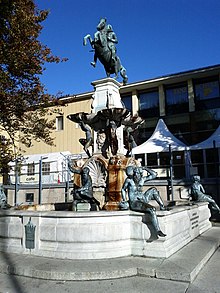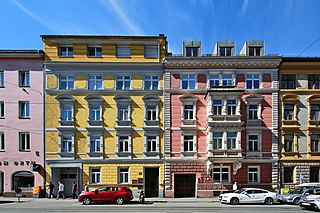
Innsbruck is the capital of Tyrol and the fifth-largest city in Austria. On the River Inn, at its junction with the Wipp Valley, which provides access to the Brenner Pass 30 km (19 mi) to the south, it had a population of 132,493 in 2018.

The Medical University of Innsbruck is a university in Innsbruck, Austria. It used to be one of the four historical faculties of the Leopold-Franzens-Universität Innsbruck and became an independent university in 2004.

Inner Austria was a term used from the late 14th to the early 17th century for the Habsburg hereditary lands south of the Semmering Pass, referring to the Imperial duchies of Styria, Carinthia and Carniola and the lands of the Austrian Littoral. The residence of the Inner Austrian archdukes and stadtholders was at the Burg castle complex in Graz.

The Goldenes Dachl is a landmark structure located in the Old Town (Altstadt) section of Innsbruck, Austria. It is considered the city's most famous symbol. Completed in 1500, the roof was decorated with 2,657 fire-gilded copper tiles for Emperor Maximilian I to mark his wedding to Bianca Maria Sforza. The Emperor and his wife used the balcony to observe festivals, tournaments, and other events that took place in the square below.
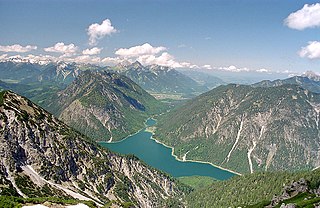
Plansee is a lake in Reutte District, Tyrol, Austria, located at 47°28′10″N10°48′20″E. Its surface is approximately 2.87 km² and its maximum depth is 78 metres.

The (Princely) County of Tyrol was an estate of the Holy Roman Empire established about 1140. After 1253, it was ruled by the House of Gorizia and from 1363 by the House of Habsburg. In 1804, the County of Tyrol, unified with the secularised prince-bishoprics of Trent and Brixen, became a crown land of the Austrian Empire. From 1867, it was a Cisleithanian crown land of Austria-Hungary.

Ambras Castle is a Renaissance castle and palace located in the hills above Innsbruck, Austria. Ambras Castle is 632 metres (2,073 ft) above sea level. Considered one of the most popular tourist attractions of the Tyrol, Ambras Castle was built in the 16th century on the spot of an earlier 10th-century castle, which became the seat of power for the Counts of Andechs. The cultural and historical importance of the castle is closely connected with Archduke Ferdinand II (1529–1595) and served as his family's residence from 1567 to 1595. Ferdinand was one of history's most prominent collectors of art. The princely sovereign of Tyrol, son of Emperor Ferdinand I, ordered that the medieval fortress at Ambras be turned into a Renaissance castle as a gift for his wife Philippine Welser. The cultured humanist from the House of Habsburg accommodated his world-famous collections in a museum: the collections, still in the Lower Castle built specifically for that museum's purpose, make Ambras Castle one of the oldest museums in the world.

Hasegg Castle is a castle and mint located in Hall in Tirol, Tyrol, Austria.

The Tyrolean Rebellion is a name given to the resistance of militiamen, peasants, craftsmen and other civilians of the County of Tyrol led by Andreas Hofer supported by his wife Anna and a strategic council consisting of Josef Speckbacher, Peter Mayr, Capuchin Father Joachim Haspinger, Major Martin Teimer and Kajetan Sveth, against new legislation and a compulsory vaccination programme concerning smallpox ordered by King Maximilian I of Bavaria, followed by the military occupation of their homeland by troops organised and financed by Napoleon I of the First French Empire and Maximilian I. The broader military context is called the War of the Fifth Coalition.

The Hofgarten is a protected park located on the edge of the Altstadt section of Innsbruck, Austria. The park covers an area of 10 hectares, and borders on the Hofburg, the Kongresshaus, and the Tyrolean State Theatre.

The Tyrolean Unterland is that part of the Austrian state of Tyrol east of its capital city, Innsbruck, excluding East Tyrol.
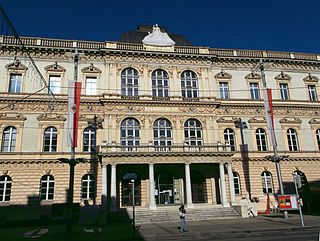
The Tyrolean State Museum, also known as the Ferdinandeum after Archduke Ferdinand, is located in Innsbruck, Austria. It was founded in 1823 by the Tyrolean State Museum Ferdinandeum Society.
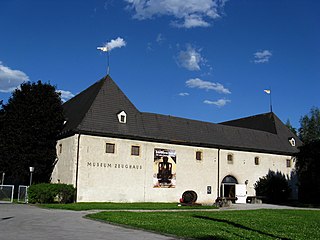
The Armoury in Innsbruck, Austria, is a former military arsenal that is now a museum. It lies in the Innsbruck quarter of Dreiheiligen.

Stubaital station was built in 1903 and, until 1983, was the terminus of the Stubai Valley Railway in Innsbruck. Since 1983 trains approaching from Fulpmes have been routed through the city of Innsbruck.

The Tyrolean State Theatre in Innsbruck is the state theatre in Innsbruck, Austria, located near the historic Altstadt section of the city. The theatre is surrounded by the Imperial Hofburg, the Hofgarten, and SOWI Faculty of the University of Innsbruck. The main theatre has about 800 seats and the studio theatre in the basement has around 250. Plays, operas, operettas, musicals and dance theatre are performed at the theatre.
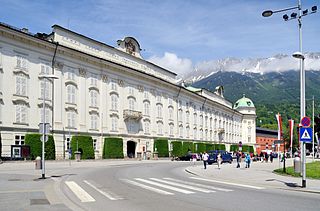
The Hofburg is a former Habsburg palace in Innsbruck, Austria, and considered one of the three most significant cultural buildings in the country, along with the Hofburg Palace and Schönbrunn Palace in Vienna. The Hofburg is the main building of a large residential complex once used by the Habsburgs that still includes the Noblewomen's Collegiate Foundation, the Silver Chapel, the Hofkirche containing Emperor Maximilian's cenotaph and the Schwarzen Mandern, the Theological University, the Tyrolean Folk Art Museum, Innsbruck Cathedral, the Congress, and the Hofgarten.

UMIT Tirol - Private University for Health Sciences and Health Technology sees itself as a health university and is located in Hall in Tirol. It was founded in 2001 in Innsbruck under the name Private University of Medical Computer Science and Technology Tirol. In connection with the expansion of the health sciences in 2004, the university was re-named UMIT – Private University for Health Sciences, Medical Informatics and Technology. Today, it's a private university under the University Accreditation Act UniAkkG BGBl. The university is run by Tyrol and the University of Innsbruck.

The Triumphal Arch is one of the best known sights in the Austrian city of Innsbruck. It is located at the southern end of the present Maria-Theresien-Straße, once the southern road out of the city.

The Tirol Panorama with the Museum of the Imperial Infantry or Tirol Panorama is a museum in Innsbruck in the Austrian state of Tyrol, which is mainly important because it houses the Innsbruck Giant Panorama Painting.

The Pogrom Monument is located on Eduard-Wallnöfer-Platz, in the centre of Innsbruck, and commemorates the November pogroms of 1938, during which the Innsbruck citizens Josef Adler, Wilhelm Bauer, Richard Berger and Richard Graubart were murdered. The memorial was erected in 1997.
